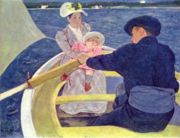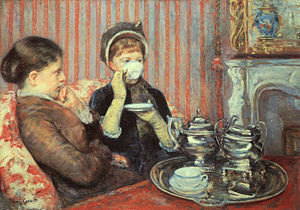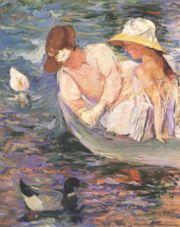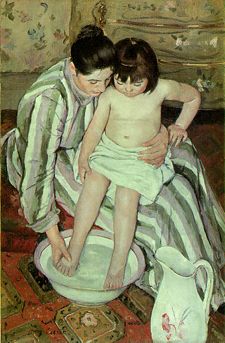Mary Cassatt
2008/9 Schools Wikipedia Selection. Related subjects: Artists
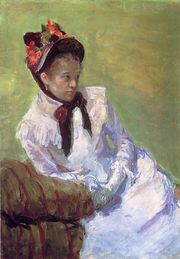
Mary Stevenson Cassatt ( May 22, 1844 – June 14, 1926) was an American painter and printmaker. She lived much of her adult life in France, where she first befriended Edgar Degas and later exhibited among the Impressionists.
Cassatt (pronounced ca-SAHT) often created images of the social and private lives of women, with particular emphasis on the intimate bonds between mothers and children.
Early life
Cassatt was born in Allegheny City, Pennsylvania, which is now part of Pittsburgh. She was born into favorable circumstances: her father, Robert S. Cassatt, was a successful stockbroker, and her mother, Katherine Kelso Johnston, came from a banking family. Cassatt grew up in an environment that viewed travel as integral to education; before she was ten years old she had already visited many of the capitals of Europe, including London, Paris, and Berlin. She was a distant cousin of Robert Henri.
Even though her family objected to her becoming a professional artist, she began studying painting at the Pennsylvania Academy of the Fine Arts in Philadelphia, Pennsylvania (1861-1865), where she made the acquaintance of fellow student Thomas Eakins. Impatient with the slow pace of instruction and the patronizing attitude of the male students and teachers, she decided to study the old masters on her own, and in December 1865 she moved to Paris. There she studied under Jean-Léon Gérôme, a highly regarded teacher who, a few months later, would also accept Eakins as a student. She augmented her artistic training with daily copying in the Louvre. Toward the end of 1866 she joined a painting class taught by Charles Chaplin, and in 1868 she also studied with Thomas Couture. In 1868 one of her paintings, A Mandoline Player, was accepted for the first time by the selection jury for the Paris Salon. This work is in the Romantic style of Corot and Couture, and is one of only two paintings from the first decade of her career that can be documented today.
Returning to the United States in the late summer of 1870—as the Franco-Prussian War was starting—Cassatt lived with her family, but art supplies and models were difficult to obtain in the small town. Her father continued to resist her chosen vocation, and paid for her basic needs, but not her art supplies. Her paintings found many admirers but no purchasers and she considered giving up art, as she was determined to make an independent living. She wrote in a letter of July, 1871, "I have given up my studio & torn up my father's portrait, & have not touched a brush for six weeks nor ever will again until I see some prospect of getting back to Europe. I am very anxious to go out west next fall & get some employment, but I have not yet decided where." Shortly afterward, her work attracted the attention of the Archbishop of Pittsburgh, who commissioned her to paint two copies of paintings by Correggio in Parma, Italy. In autumn of 1871 she returned to Europe, heading quickly to her task in Italy.
Impressionism
Within months of her return to Europe her prospects had brightened. Her painting in the Salon of 1872 was well received and was purchased, and she attracted much favorable notice in Parma. She traveled to Madrid and Seville, where she painted a group of pictures of Spanish subjects, such as Spanish Dancer Wearing a Lace Mantilla (1873, in the National Museum of American Art, Smithsonian Institution). Nevertheless, she expressed criticisms of the politics of the Salon and the conventional taste that prevailed there. She saw that works by female artists were often dismissed with contempt unless the artist had a friend or protector on the jury, and she would not flirt with jurors to curry favour. Her cynicism grew when one of the two pictures she submitted in 1875 was refused by the jury, only to be accepted the following year after she darkened the background. In 1877 both her entries were rejected, and for the first time in seven years she had no works in the Salon.
At this low point in her career she was invited by Edgar Degas to show her works with the Impressionists, a group that had begun their own series of independent exhibitions in 1874 with much attendant notoriety. Cassatt admired Degas, whose pastels had made a powerful impression on her when she encountered them in an art dealer's window in 1875. "I used to go and flatten my nose against that window and absorb all I could of his art," she later recalled. "It changed my life. I saw art then as I wanted to see it." She accepted Degas' invitation with enthusiasm, and began preparing paintings for the next Impressionist show, planned for 1878, which (after a postponement) took place on April 10, 1879.
Her style had gained a new spontaneity during the intervening two years. Previously a studio-bound artist, she had adopted the practice of carrying a sketchbook with her to record the scenes she saw. Although critics claimed that her colors were too bright and that her portraits were too accurate to be flattering to the subjects, her work was not savaged by the critics as was Monet's. She remained an active member of the Impressionist circle until 1886, and enjoyed friendships with Degas and Berthe Morisot. As with Degas, Cassatt became extremely proficient in the use of pastels, eventually painting many of her most important works in this medium.
In 1877, Cassatt was joined in Paris by her mother and her sister, Lydia. Mary valued their companionship, as neither she nor Lydia had married; Mary had decided early in life that marriage would be incompatible with her career. Lydia, who was frequently painted by her sister, suffered from recurrent bouts of illness, and her death in 1882 left Cassatt temporarily unable to work. Her style evolved, and she moved away from Impressionism to a simpler, more straightforward approach. After 1886, she no longer identified herself with any art movement and experimented with a variety of techniques.
Cassatt's popular reputation is based on an extensive series of rigorously drawn, tenderly observed, yet largely unsentimental paintings and prints on the theme of the mother and child. The earliest dated work on this subject is the drypoint Gardner Held by His Mother (an impression inscribed "Jan/88" is in the New York Public Library), although she had painted a few earlier works on the theme. Some of these works depict her own relatives, friends, or clients, although in her later years she generally used professional models in compositions that are often reminiscent of Italian Renaissance depictions of the Madonna and Child. After 1900, she concentrated almost exclusively on mother-and-child subjects.
In 1891, she exhibited a series of highly original colored drypoint and aquatint prints, including Woman Bathing and The Coiffure, inspired by the Japanese masters shown in Paris the year before. (See Japonism)
Later life
The 1890s were Cassatt's busiest and most creative time. She also became a role model for young American artists who sought her advice. Among them was Lucy A. Bacon, whom Cassatt introduced to Camille Pissarro. As the new century arrived, she served as an advisor to several major art collectors and stipulated that they eventually donate their purchases to American art museums. Although instrumental in advising the American collectors, recognition of her art came more slowly in the United States.
Mary Cassatt's brother, Alexander Cassatt, (president of the Pennsylvania Railroad from 1899 until his death) died in 1906. She was shaken, as they had been close, but she continued to be very productive in the years leading up to 1910. An increasing sentimentality is apparent in her work of the 1900s; her work was popular with the public and the critics, but she was no longer breaking new ground, and her Impressionist colleagues who once provided stimulation and criticism were dying off. She was hostile to such new developments in art as post-Impressionism, Fauvism and Cubism.
A trip to Egypt in 1910 impressed Cassatt with the beauty of its ancient art, but was followed by a crisis of creativity; not only had the trip exhausted her, but she declared herself "crushed by the strength of this Art", saying, "I fought against it but it conquered, it is surely the greatest Art the past has left us ... how are my feeble hands to ever paint the effect on me." Diagnosed with diabetes, rheumatism, neuralgia, and cataracts in 1911, she did not slow down, but after 1914 she was forced to stop painting as she became almost blind. Nonetheless, she took up the cause of women's suffrage, and in 1915, she showed eighteen works in an exhibition supporting the movement.
In recognition of her contributions to the arts, France awarded her the Légion d'honneur in 1904.
She died on June 14, 1926 at Château de Beaufresne, near Paris, and was buried in the family vault at Mesnil-Théribus, France.
As of 2005 her paintings have sold for as much as $2.87 million.
